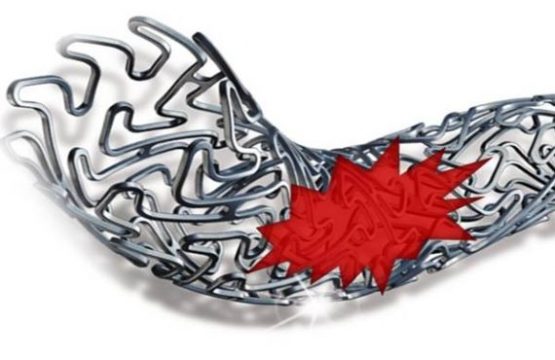Original Title: Femoropopliteal Artery Stent Thrombosis. Report from the Excellence in Peripheral Artery Disease Registry. Reference: Subhash Banerjee et al. Circ Cardiovasc Interv. 2016 Feb;9(2):e002730. There is limited information on peripheral stent thrombosis and involved factors. This study analyzed 604 stent procedures in femoropopliteal territory form the multicenter registry “Excellence in Peripheral Artery Disease”. Stent…
Bivalirudin could be beneficial in peripheral PCI
Original Title: Bivalirudin Is Associated with Improved In-Hospital Outcomes Compared with Heparin in Percutaneous Vascular Intervention. Observational, Propensity –Matched Analysis From the Premier Hospital Database. Reference: Carey Kimmeslstiel, et al. Circ Cardiovasc Interv. 2016 Jan;9(1). Courtesy of Dr. Carlos Fava Lower limb vascular interventions are increasing in number and bleeding is one of its most…
Sustained Benefit of Treatment with Drug-Coated Balloon for Femoropopliteal Lesions.IN.PACT SFA Results at 24 months
Original Title: Sustained Durability of Treatment Effect Using a Drug-Coated Balloon for Femoropopliteal Lesions. 24-Month Results of IN.PACT SFA. Reference: John R. Laird et al. J Am CollCardiol. 2015 [Epub ahead of print]. The IN.PACT SFA studies and follows up patients treated with IN.PACT Admiral DCB (Medtronic®) for superficial femoral artery (SFA) and popliteal artery disease.…
Angioplasty using a drug eluting balloon in the superficial femoral artery
Original title: Drug-Coated Balloon Versus Standard Percutaneous Transluminal Angioplasty for the Treatment of Superficial Femoral and Popliteal Peripheral Artery Disease 12-Month Results From the IN.PACT SFA Randomized Trial. Reference: Gunnar Tepe et al. Circulation. 2015;131:495-502. This interesting study randomly selected 331 patients with intermittent claudication or ischemic rest pain due to stenosis of the superficial femoral artery or…
Supervised exercise is as important as revascularization in aortoiliac peripheral artery disease
Original title: Supervised Exercise, Stent Revascularization, or Medical Therapy for Claudication Due to Aortoiliac Peripheral Artery DiseaseThe CLEVER Study. Reference: J Am Coll Cardiol. 2015;65(10):999-1009. Percutaneous revascularization has been effective to treat claudication due to aortoiliac peripheral artery disease. However, supervised exercise can also offer benefits in terms of functional class and quality of life, at least in…
The poor prognosis of critical limb ischemia related to sub treatment
Original title: Peripheral arterial disease and critical limb ischaemia: still poor outcomes and lack of guideline adherence. Reference: Reinecke H et al. Eur Heart J. 2015; Epub ahead of print. This work included 41882 patients retrospectively from health insurance in Germany admitted with diagnosis of peripheral vascular disease between 2009 and 2011 and followed until 2013. Patients…
Bioabsorbable stents also in peripheral territory
Original title: Evaluation of the Biodegradable Peripheral Igaki-Tamai Stent in the Treatmentof De Novo Lesions in the Superficial Femoral Artery. The GAIA Study. Reference: Martin Werner et al. J Am Coll Cardiol Intv 2014;7:305–12. The aim of this study was to assess the safety and efficacy of the biodegradable stent Igaki-Tamai (Igaki Medical Planning Company, Kyoto, Japan) in…
Complications of peripheral angioplasty access
Original title: Access Site Complications After Peripheral Vascular Interventions. Incidence, Predictors, and Outcomes. Reference: Daniel Ortiz et al. Circ Cardiovasc Interv. 2014 Nov 11. Epub ahead of print. Hematomas and pseudoaneurysms are the most common complications of peripheral angioplasty, though its incidence and risk factors are unclear. A retrospective analysis was performed in 22226 patients receiving peripheral…
Invasive Strategies Improve Quality of Life in Claudicants
Original title: Improved Quality of Life After One Year With an Invasive Versus a Non-Invasive Treatment Strategy in Claudicants: One Year Results of the IRONIC Trial. Reference: Joakim Nordanstig et al. CIRCULATIONAHA.114.009867. Published online before print August 2014. The quality of studies comparing invasive vs. non-invasive strategies in claudicants is low or very low and, most frequently, consist…
Superficial Femoral Artery In-Stent Restenosis with Drug Eluting Balloon: 2 Year Follow Up.
Original title: Drug-Eluting Balloons for the Treatment of the Superficial Femoral Artery In-Stent Restenosis. 2-Year Follow-Up. Reference: Vittorio Virga et al. J Am Coll Cardiol Intv 2014;7:411–5. Although the use of the self-expanding nitinol stent has improved angioplasty outcomes in femoropopliteal territory, restenosis remains a challenge still affecting at least 25% of the population in the first year.…
Angioplasty versus surgery in patients with critical lower limb ischemia
Original title: Comparative effectiveness of endovascular andsurgical revascularization for patients with peripheralartery disease and critical limb ischemia: Systematicreview of revascularization in critical limb ischemia. Reference: W Schuyler Jones, et al. (Am Heart J 2014; 167:167:489-498.e7) Lower limbs critical ischemia is the most severe condition of PAD. The morbidity, mortality and costs related thereto are well documented; however, the…










